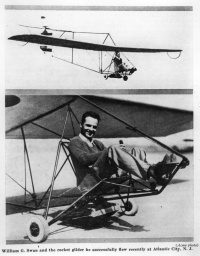Steel Pier Rocket Glider by Ron Miller
From The Space Library
Chuck Yeager shattered the sound barrier in the Bell X-1, and the X-15 was perhaps the world's first spaceship. But these fabulous machines hardly sprang into being from nothing. They were the products of a long evolution of rocket-propelled aircraft, whose strangest episode may have come when the very first American rocketed into the skies in the 1930s.
Rocket flight has its roots in the seventeenth century, when legend tells (in tantalizingly explicit detail) of a rocket-glider flight supposedly made by one Lagari Hassan Celebi.
The first living creature on record to have been launched by a rocket was a ram sent to an altitude of 600 feet by Claude Ruggieri in 1806. The animal survived. Inspired, Ruggieri tried to find a volunteer for a manned flight in 1830...until the police stepped in (largely because Ruggieri had recruited a child). In 1871 an anonymous inventor suffered in reality the imaginary fate of the apocryphal Chinese rocketeer Wan Hoo—an experiment repeated in 1913 by F. Rodman Law, but with less fatal results.
Between the last half of the nineteenth century and the first decade of the twentieth, rockets were applied to model aircraft several times. In fact, magazines were filled with ads for model rocket planes or instructions for building them...but no one thought of working on a larger scale, let alone being a pilot. During this time, however, the idea that space travel might be a real possibility was taking a strong hold on not only the public imagination but that of scientists and engineers as well. It was clear to the latter that the only realistic method of reaching space was through the use of rockets.
One of the biggest problems they faced was the reputation of the rocket itself. The rocket at the beginning of the twentieth century was scarcely improved from the Hale rockets of the Civil War. Their unreliability, small size and lack of power was one of the reasons Jules Verne chose to launch his astronauts by means of a giant cannon. One way to prove the effectiveness of rockets as a viable method of propulsion to a skeptical public was to attach them to assorted vehicles. On June 11, 1928, the first piloted, rocket-propelled aircraft was flown in Germany. This was followed by many others, mostly also in Germany with Italy following in 1931. The Russians didn't begin experimenting with rocket gliders until 1932.
The first American to fly a rocket-propelled aircraft did so on June 4, 1931.
This was a 29-year-old stunt pilot named William G. Swann. In part to promote himself and in part to advertise the Steel Pier amusement park in Atlantic City, Swann attached ten solid-fuel rocket motors of 50 pounds thrust each to his high-winged glider (which closely resembled the ultralights of today). All the rockets could be ignited by the pilot. In front of a crowd of 2000 people, Swann ignited just one rocket. The glider, from a standing start, took off and flew 1000 feet at an altitude of 100 feet. The next day, Swann attached twelve rockets (in bundles of six each) to the glider and ignited all of them. Despite facing a strong wind, he took off at a speed of 35 mph, managed to achieve an altitude of 200 feet and remained aloft for eight minutes.
While Swann was scarcely the first human to fly under rocket power, he did have some foresight. According to one newspaper report, "No attempt was made at continuous flight, the rockets being used as a launching medium only." The reporter concluded that "the ground crews hitherto needed for glider flying may soon be dispensed with..." And he was right: Swann anticipated the technique of rocket-assisted take-off that would prove indispensable a decade later during World War II.




